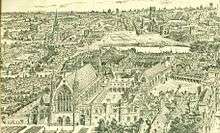Ely Place
Ely Place /ˈiːli/ (![]()

It is privately managed by its own body of commissioners and beadles.
Ely Place is sometimes claimed to have been an exclave of Cambridgeshire due to that county containing the medieval abbey at Ely, and Ely Place having been the site of the London residence of the Bishops of Ely who regularly lived on the site from 1290 to 1772. However, Ely Place was never formally part of the county of Cambridgeshire, or outside the Metropolitan Police area, and had no special status beyond being an extra-parochial area.[1]
History

Origins
Ely Place stands on land that had been the site of Ely Palace or Ely House, the London townhouse of the Bishops of Ely from 1290 to 1772.[2] Land in the Holborn area was bought by John de Kirkby in 1280. He was appointed Bishop of Ely in 1286 and on his death in 1290, he left the estate to the see of Ely.[2] In medieval times, bishops of Ely frequently held high state office requiring them to live in London; Ely Palace was the bishop's official residence.
References to Ely Palace grounds occur in Shakespeare’s plays. It was at the house that in King Richard II, the Bard had John of Gaunt – who was living there in 1382 – says his "This royal throne of Kings, this sceptre’d isle" speech.[3]

On 17 October 1546, James Butler, 9th Earl of Ormond, a powerful Munster landowner who had served in the household of Cardinal Wolsey in his youth, and who had crossed the quarrelsome Lord Deputy of Ireland, Sir Anthony St Leger, was visiting London with his household. They were invited to dine at Ely Palace, where Ormond was poisoned along with his steward and 16 of his household, it was widely assumed, at the instructions of St Leger.
The estate was granted to Sir Christopher Hatton in 1577 after a commission was set up by Queen Elizabeth I, headed by John Aylmer (Bishop of London) to investigate the claims that Sir Christopher Hatton should be granted the freehold of the land after he acquired a 21 years lease on the estate and spent a sum of the £1,887 5s 8d (equivalent to £541,687 in 2019) on renovations and repairs. The commission declared in June 1577 that Ely Place should stay with Bishop Cox if he could reimburse Sir Christopher Hatton in whole for the outlay but he could not. A new lease was drawn up giving Sir Christopher Hatton control of the property freehold. He gave his name to Hatton Garden which occupies part of the site.
The estate was sold to the Crown in 1772. The cul-de-sac was constructed in 1772 by Robert Taylor.[2] Edmund Keene as Bishop of Ely commissioned a new Ely House, also built by Taylor, on Dover Street, Mayfair.[2]
St Etheldreda's Church
St Etheldreda's Church in Ely Place is the former private chapel of the Bishops of Ely. It is one of two surviving buildings in London from the reign of Edward I (1272–1307) although it was badly damaged during World War II. St Etheldreda, a seventh-century queen and founding abbess of the monastery at Ely, was the saint in whose name Ely Cathedral was dedicated. The gardens of St Etheldreda were said to produce the finest strawberries in London and a Strawberry Fayre is held here every June. In Shakespeare’s Richard III, Gloucester tells the Bishop of Ely: "My Lord of Ely, when I was last in Holborn, I saw good strawberries in your garden there. I do beseech you, send for some of them".
Commissioners

In 1842 a local Act of Parliament established a body of commissioners for paving, lighting, watching, cleansing and improving Ely Place and Ely Mews, Holborn, in the County of Middlesex.[4] While the commissioners have lost most of their powers to local authorities established under the Metropolis Management Act 1855 and later legislation, they retain their "watching" duties, with a beadle discharging these duties.
Transport
To the east is Farringdon Road and to the south is Holborn Circus. To the north is a gate leading to Bleeding Heart Yard. The nearest underground stations are Farringdon to the north-east and Chancery Lane to the west.
References
- ianvisits.co.uk/blog/2019/05/27/londons-alleys-ely-place-ec1/
- Richardson, J., The Annals of London, (2000)
- King Richard II Act 2, Scene 1
- 5 & 6 Vict. c.xlviii